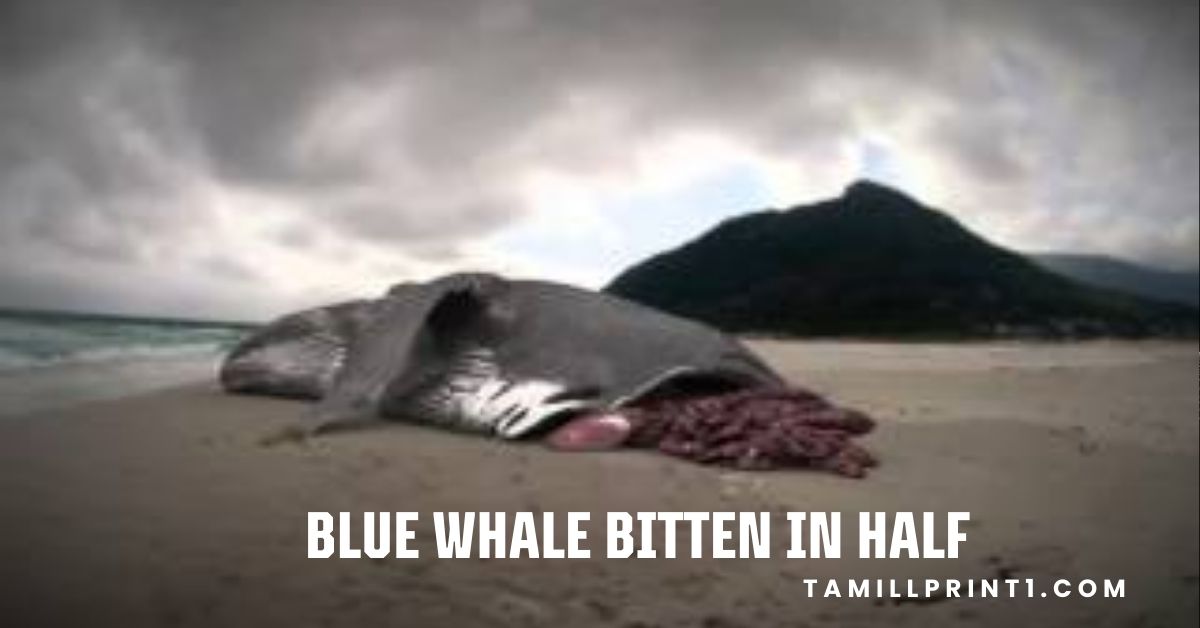The phrase “blue whale bitten in half” has taken the internet by storm, sparking curiosity, fear, and speculation. When a massive blue whale carcass was found in South Africa, seemingly bitten in half, it raised several pressing questions: What could have done this? How did it happen? Is there a predator capable of such an attack? In this article, we will explore the facts, possible causes, and the science behind this shocking event in detail.
What Really Happened?
The incident first gained attention when social media users shared images of a blue whale carcass washed ashore in South Africa. The whale appeared to have been bitten in half, leading to wild theories and speculation. The photos quickly went viral, with many users attributing the attack to giant sea creatures, megalodons, or mysterious deep-sea predators. However, experts believe there are more rational explanations.

Verified Facts About the Incident:
- The blue whale was found partially eaten, with a large portion missing, making it appear as if it was bitten in half.
- The bite marks suggested a massive predator, possibly an apex predator of the ocean.
- The incident was reported in South Africa, a region known for its rich marine biodiversity, including sharks and killer whales.
- Marine biologists and experts began investigating the circumstances surrounding the carcass.
- While the event is unusual, similar cases of whale predation have been recorded in the past.
Possible Causes: What Could Have Bitten the Blue Whale in Half?
There are only a few creatures in the ocean powerful enough to seriously injure or kill a blue whale. Below, we explore the leading explanations:
Also Read: TributeonPrintedPics: A Heartfelt Way to Preserve Memories
1. Great White Sharks
One of the most probable culprits is the great white shark (Carcharodon carcharias). South African waters are home to some of the largest great white sharks in the world, with recorded specimens reaching lengths of up to 20 feet (6 meters).
- Scavengers, not hunters: While great white sharks are powerful predators, they rarely attack fully grown blue whales. Instead, they scavenge on already dead or dying whales.
- Bite force and teeth: Great whites have razor-sharp teeth and an incredibly powerful bite force (around 4,000 psi), making them capable of taking large chunks out of a whale carcass.
- Historical cases: Great white sharks have been observed feeding on dead whales, leaving similar bite patterns as seen in this case.
- Shark migration patterns: Large sharks often migrate through South African waters, making it plausible that a group of sharks fed on an already dead whale.
2. Orcas (Killer Whales)
Another strong contender is the orca (Orcinus orca), known for its intelligence and pack-hunting behavior. Killer whales are known to attack large marine mammals, including:
- Grey whales, humpback whales, and even juvenile blue whales.
- Other large sea creatures, including dolphins and seals.
- Large fish and even great white sharks in some cases.
Could orcas bite a blue whale in half?
- While orcas are not known to physically sever a whale in one bite, they coordinate attacks in groups, systematically wearing down their prey.
- Orca feeding behaviors involve biting off chunks of blubber and flesh, which could result in the appearance of a half-bitten whale.
- Past incidents suggest that orcas can successfully take down juvenile blue whales, though they usually target smaller prey.
3. Megalodon Theory: Fact or Fiction?
One of the most viral speculations is that the megalodon (Otodus megalodon)—an extinct giant shark—was responsible. This theory gained traction due to:
- The size of the bite: Some claimed the bite radius was too large for any known predator, leading to speculation about a prehistoric shark.
- Megalodon myths: The idea of a massive, undiscovered predator still lurking in the ocean excites people and fuels conspiracy theories.
Scientific Consensus:
- Megalodon went extinct around 3.6 million years ago.
- No modern evidence supports the existence of living megalodons.
- The most logical explanation remains modern predators like sharks or orcas scavenging on a dead whale.
Also Read: Aggreg8Net Dave Watkin: A Comprehensive Analysis of Innovation in Data Aggregation
Why Did This Blue Whale End Up as Prey?
While blue whales are the largest animals on Earth, they are not invincible. Several factors may have made this whale vulnerable:
- Old Age or Sickness – A weak or sick whale is an easier target for predators.
- Injury from Human Activity – Ship strikes or entanglement in fishing gear could have left the whale defenseless.
- Natural Death and Scavenging – It is possible that the whale died naturally, and predators simply fed on its remains.
- Shark and Orca Activity – The presence of large predators in the area could have led to opportunistic feeding on the whale.
The Impact of This Event on Marine Science
Marine biologists and oceanographers study such cases to understand predator-prey relationships in the ocean. This incident has:
- Provided insights into shark and orca feeding behaviors.
- Sparked public interest in marine life and conservation.
- Raised awareness about whale deaths and their causes.
- Encouraged scientific investigation into unusual marine occurrences.
Final Verdict: What Really Happened?
After reviewing all available evidence, the most scientifically backed explanation is that the blue whale either died of natural causes or was already weakened, and predators like great white sharks or orcas scavenged on its remains. While the idea of a megalodon or an unknown sea monster is thrilling, there is no scientific evidence to support such claims.
Also Read: Songoftruth org: A Safe and Enjoyable Learning Platform for Families
FAQs about Blue Whale Bitten in Half
What caused the “blue whale bitten in half” incident?
The blue whale was likely scavenged by great white sharks or orcas after dying naturally or due to injury.
Could a megalodon be responsible?
No, megalodons went extinct millions of years ago, and there is no evidence they still exist.
Where did this incident take place?
The blue whale carcass was found in South African waters.
Do great white sharks attack blue whales?
Great white sharks generally do not attack healthy adult blue whales, but they scavenge on whale carcasses.
Can orcas kill a blue whale?
Yes, pods of orcas have been observed attacking and killing juvenile blue whales.
Is this a rare event?
Yes, while whale deaths and scavenging are common, finding a blue whale bitten in half is unusual.
How can we prevent whale deaths?
Reducing ship strikes, plastic pollution, and fishing gear entanglements can help protect whales from human-related threats.
Conclusion
The blue whale bitten in half incident showcases the natural cycle of marine life. While thrilling theories about giant sea monsters or megalodons capture public imagination, the most logical explanation remains predation and scavenging by known oceanic predators. This event has highlighted the importance of marine conservation and further research into oceanic predators.







